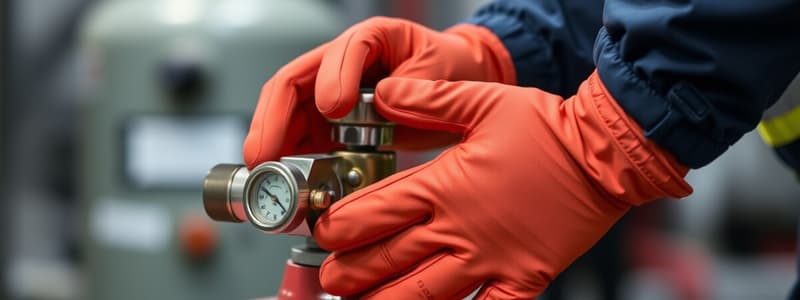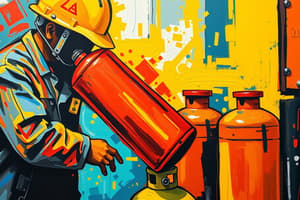Podcast
Questions and Answers
Hazards associated with compressed gases include:
Hazards associated with compressed gases include:
- Oxygen displacement
- Explosions
- Toxic gas exposures
- All of the above (correct)
Which of the following statements regarding the use of gloves is correct?
Which of the following statements regarding the use of gloves is correct?
- It is acceptable to wear multiple layers of gloves and peel off each layer between tasks
- It is acceptable to reuse gloves if you wash them first
- Turn gloves inside out when removing them (correct)
- You do not need to wash your hands before putting on gloves
If a person is injured at the hospital during a natural disaster, a correct action to take is:
If a person is injured at the hospital during a natural disaster, a correct action to take is:
- Try to move the person yourself
- Report the accident only if the person had to go to the Emergency Department
- Use a wheelchair or a stretcher to take the person to the Emergency Department for treatment (correct)
- Turn a person with a head injury onto his or her back
Before you use a chemical product, you must know certain important information about it. Which of the choices below is information you do NOT need to know?
Before you use a chemical product, you must know certain important information about it. Which of the choices below is information you do NOT need to know?
Healthcare workers who must comply with HIPAA privacy requirements are:
Healthcare workers who must comply with HIPAA privacy requirements are:
Which of the following is NOT required on a chemical label?
Which of the following is NOT required on a chemical label?
The acronym P.A.S.S. is used to help remember:
The acronym P.A.S.S. is used to help remember:
When lifting something off the ground, which part of your body should you always use?
When lifting something off the ground, which part of your body should you always use?
Which of the following statements regarding electrical safety is correct?
Which of the following statements regarding electrical safety is correct?
Placing a patient on Contact Precautions means that everyone must:
Placing a patient on Contact Precautions means that everyone must:
When mobilizing a weak or unsteady patient, which technique(s) should you consider?
When mobilizing a weak or unsteady patient, which technique(s) should you consider?
Which of the following would be considered an internal disaster rather than an external one?
Which of the following would be considered an internal disaster rather than an external one?
In the event of an earthquake, which of the following should never be done?
In the event of an earthquake, which of the following should never be done?
When working with or near radiation, which of the following statements is incorrect?
When working with or near radiation, which of the following statements is incorrect?
When moving a patient from bed to wheelchair, which technique should you avoid at all times?
When moving a patient from bed to wheelchair, which technique should you avoid at all times?
If patients need to be evacuated, it should be in this order:
If patients need to be evacuated, it should be in this order:
Under the Safe Medical Devices Act, your responsibility as a healthcare worker is to:
Under the Safe Medical Devices Act, your responsibility as a healthcare worker is to:
Which of the following would be considered part of a healthcare worker's role in the event of an emergency involving a biologic or chemical exposure?
Which of the following would be considered part of a healthcare worker's role in the event of an emergency involving a biologic or chemical exposure?
Under HIPAA, patients have the right to do all of the following EXCEPT:
Under HIPAA, patients have the right to do all of the following EXCEPT:
Which of the following is true about chemical exposure?
Which of the following is true about chemical exposure?
The activity that puts the most continuous pressure on the lumbar region of your lower back is:
The activity that puts the most continuous pressure on the lumbar region of your lower back is:
Which of the following could compromise a patient's Protected Health Information (PHI)?
Which of the following could compromise a patient's Protected Health Information (PHI)?
It is a requirement under HIPAA that:
It is a requirement under HIPAA that:
According to labeling guidelines, only two 'Signal Words' can appear on a label. One is Danger and the other is:
According to labeling guidelines, only two 'Signal Words' can appear on a label. One is Danger and the other is:
In the event of a fire, you should never:
In the event of a fire, you should never:
The Safety Data Sheet (SDS), formerly called MSDS, provides details on:
The Safety Data Sheet (SDS), formerly called MSDS, provides details on:
When moving a patient, what should you always avoid doing?
When moving a patient, what should you always avoid doing?
Which of the following statements regarding sharps is correct?
Which of the following statements regarding sharps is correct?
In the event of a fire, which are the correct steps to take?
In the event of a fire, which are the correct steps to take?
Standard precautions require that:
Standard precautions require that:
You may disclose a patient's Protected Health Information (PHI) without the patient's consent for all of the following reasons EXCEPT:
You may disclose a patient's Protected Health Information (PHI) without the patient's consent for all of the following reasons EXCEPT:
The single most important practice in preventing infection is:
The single most important practice in preventing infection is:
According to The Joint Commission, an effective emergency management plan includes four key principles: Mitigation, Preparation, Response, and _________________.
According to The Joint Commission, an effective emergency management plan includes four key principles: Mitigation, Preparation, Response, and _________________.
If you discover a person on fire:
If you discover a person on fire:
In the event of a telephone bomb threat, you should:
In the event of a telephone bomb threat, you should:
Flashcards
Compressed Gas Hazards
Compressed Gas Hazards
Hazards include oxygen displacement, explosions, and toxic gas exposure.
Proper Glove Usage
Proper Glove Usage
Turn inside out when removing; wash hands before use.
R.A.C.E. Acronym
R.A.C.E. Acronym
Rescue, Activate alarm, Confine fire, Extinguish if safe.
Patient Evacuation Order
Patient Evacuation Order
Signup and view all the flashcards
Hand Washing
Hand Washing
Signup and view all the flashcards
R.A.C.E.
R.A.C.E.
Signup and view all the flashcards
RACE
RACE
Signup and view all the flashcards
Person on Fire
Person on Fire
Signup and view all the flashcards
Chemical Label Requirements
Chemical Label Requirements
Signup and view all the flashcards
Chemical Exposure Knowledge
Chemical Exposure Knowledge
Signup and view all the flashcards
P.A.S.S.
P.A.S.S.
Signup and view all the flashcards
Emergency Management Elements
Emergency Management Elements
Signup and view all the flashcards
HIPAA Patient Rights
HIPAA Patient Rights
Signup and view all the flashcards
PHI Protection
PHI Protection
Signup and view all the flashcards
Safety Data Sheet (SDS)
Safety Data Sheet (SDS)
Signup and view all the flashcards
Standard Precautions
Standard Precautions
Signup and view all the flashcards
Bomb Threat (Phone)
Bomb Threat (Phone)
Signup and view all the flashcards
Proper Lifting
Proper Lifting
Signup and view all the flashcards
Electrical Safety Rules
Electrical Safety Rules
Signup and view all the flashcards
Protecting Health Information (PHI)
Protecting Health Information (PHI)
Signup and view all the flashcards
Chemical Exposure Effects
Chemical Exposure Effects
Signup and view all the flashcards
Handle Sharps Properly
Handle Sharps Properly
Signup and view all the flashcards
Study Notes
Hazards and Safety Protocols
- Compressed gases pose hazards including oxygen displacement, explosions, and toxic gas exposure.
- Proper glove usage involves turning them inside out when removing; washing hands before use is crucial.
- In case of a head injury during a natural disaster, always turn the patient onto their back.
Chemical and Radiation Safety
- Knowing the proper use, safe handling precautions, and treatment for chemical exposure is essential; specific chemical composition is not always necessary.
- Medical staff must comply with HIPAA privacy rules, applying to all personnel involved in patient care.
- Chemical labels require signal words and hazard statements, but facility names are not mandatory.
Fire Safety and Emergency Response
- The acronym P.A.S.S. helps remember fire extinguisher usage procedures.
- Always lift using your legs to prevent back strain and damage.
- Electrical safety rules include avoiding rolling equipment over cords and unplugging devices by the plug, not the cord.
Patient Care and Mobility
- Use appropriate Personal Protective Equipment (PPE) for Contact Precautions and ensure all safety measures are followed during patient mobility.
- Evacuate patients in order: ambulatory, followed by wheelchair-users, then bedfast patients.
- In emergency situations, recognize biologic or chemical exposure symptoms and report them effectively.
HIPAA Regulations
- Under HIPAA, patients may request their medical records, know who accessed their information, and inspect their records; they cannot alter them independently.
- Protecting Health Information (PHI) includes avoiding disposal of printed records in regular trash.
Chemical Exposure Effects
- Some effects of hazardous chemicals may take years to surface, making awareness and caution vital.
- Properly handle sharps to prevent injury; never recap contaminated needles.
- The Safety Data Sheet (SDS) provides comprehensive information regarding hazardous materials, including dangers and emergency procedures.
Emergency Management and Procedures
- Follow R.A.C.E. for fire emergencies: Rescue, Activate alarm, Confine fire, Extinguish if safe.
- Treat all blood and body fluids as infectious, implementing standard precautions at all times.
- Effective emergency management involves preparation, response, recovery, and mitigation.
Infection Control Practices
- Hand washing is the most vital practice in preventing infections in healthcare settings.
- Should an individual be discovered on fire, wrap them in a blanket to extinguish flames without fanning them.
- In the case of a bomb threat via phone, carefully document the call details as instructed, rather than terminating the conversation.
Studying That Suits You
Use AI to generate personalized quizzes and flashcards to suit your learning preferences.




